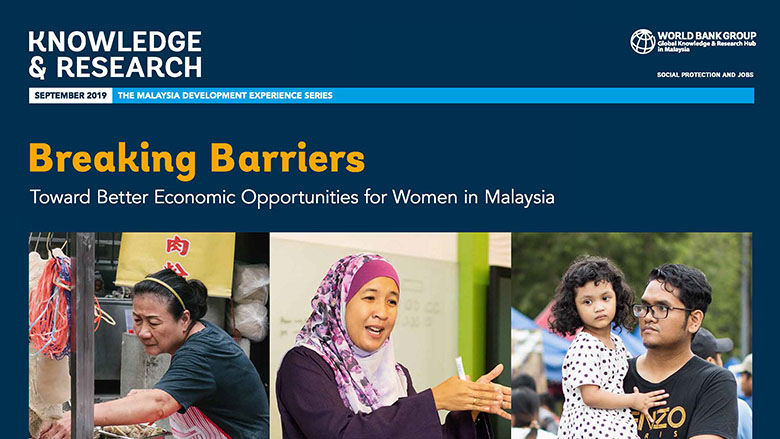KEY FINDINGS
The promotion of economic opportunities for women is one of the most promising avenues for Malaysia’s future development. If all economic barriers are removed for women in Malaysia, the country’s income per capita could grow by 26.2% – implying an average annual income gain of RM 9,400 (US$2,250).
- Malaysia’s female labor force participation rate has risen significantly in recent years, from 46.8% in 2010 to 55.2% in 2018 but remains low given Malaysia’s level of development and when compared to other countries in Southeast Asia.
- In 2018, 80.4% of working-age men were in the labor market but for women, only 55.2% were involved.
- Women’s economic empowerment will require removing barriers to create more productive employment for women, especially to greater education opportunities, labor force participation and employment.
Education and labor force participation
- Women in Malaysia’s labor force are, on average, better educated than men.
- Female students outperform male students in standardized assessments of learning outcomes such as in mathematics and science.
- More than 50% of women are graduates, across all types of degrees and institutions, including polytechnic and community colleges.
- Housework is cited as the main constraint preventing women from participating in the labor force.
- Ensuring equal access for women to economic opportunities is a policy challenge in order to unlock their potential.
Employment
- The share of women in the informal sector has generally risen and is now higher than the share of men, which impacts their productivity and social protection.
- Women’s average earnings are significantly lower than men’s for almost all major occupational and educational groups, especially among workers without primary education or any other type of formal education.
- There were more women than men employed in sectors traditionally characterized as “female” such as education (65.4%), health and social work (68.7%), and household work (92%) based on 2010 findings. In 2018, these patterns have broadly not changed.
RECOMMENDATIONS
To ensure equal access to productive jobs, Malaysia should look towards policy directions that facilitate economic opportunities for women. These include:
- Expanding the availability, quality and affordability of child and elderly care as part of a comprehensive policy approach. This includes increasing child care coverage from 0–6 years to 0–17 years and prioritizing resources on child and elderly care for the bottom 40%, especially the urban poor.
- Strengthening the protection and productivity of informal workers and business owners to harness women’s full economic potential.
- Pursuing planned reforms of the legal environment and strengthening the implementation, monitoring and enforcement of laws and regulations.
- Improving support for parents in line with international legal norms.
- Addressing gender norms and attitudes in education and among the wider population
